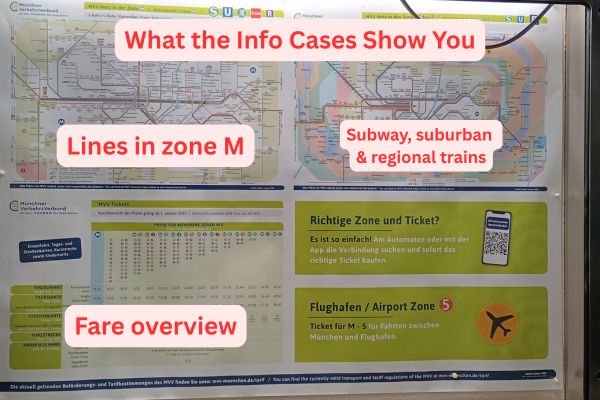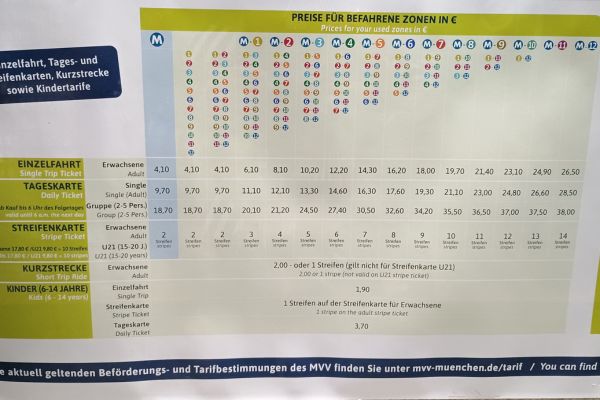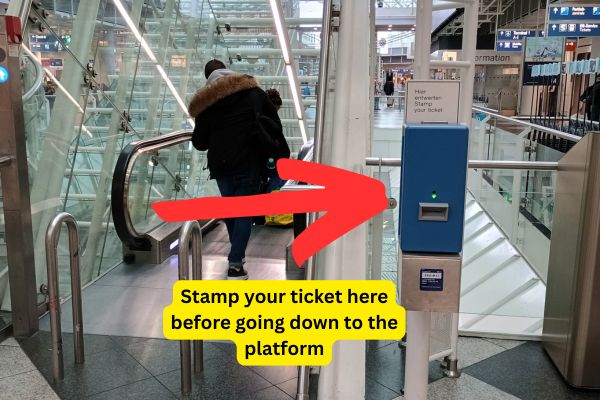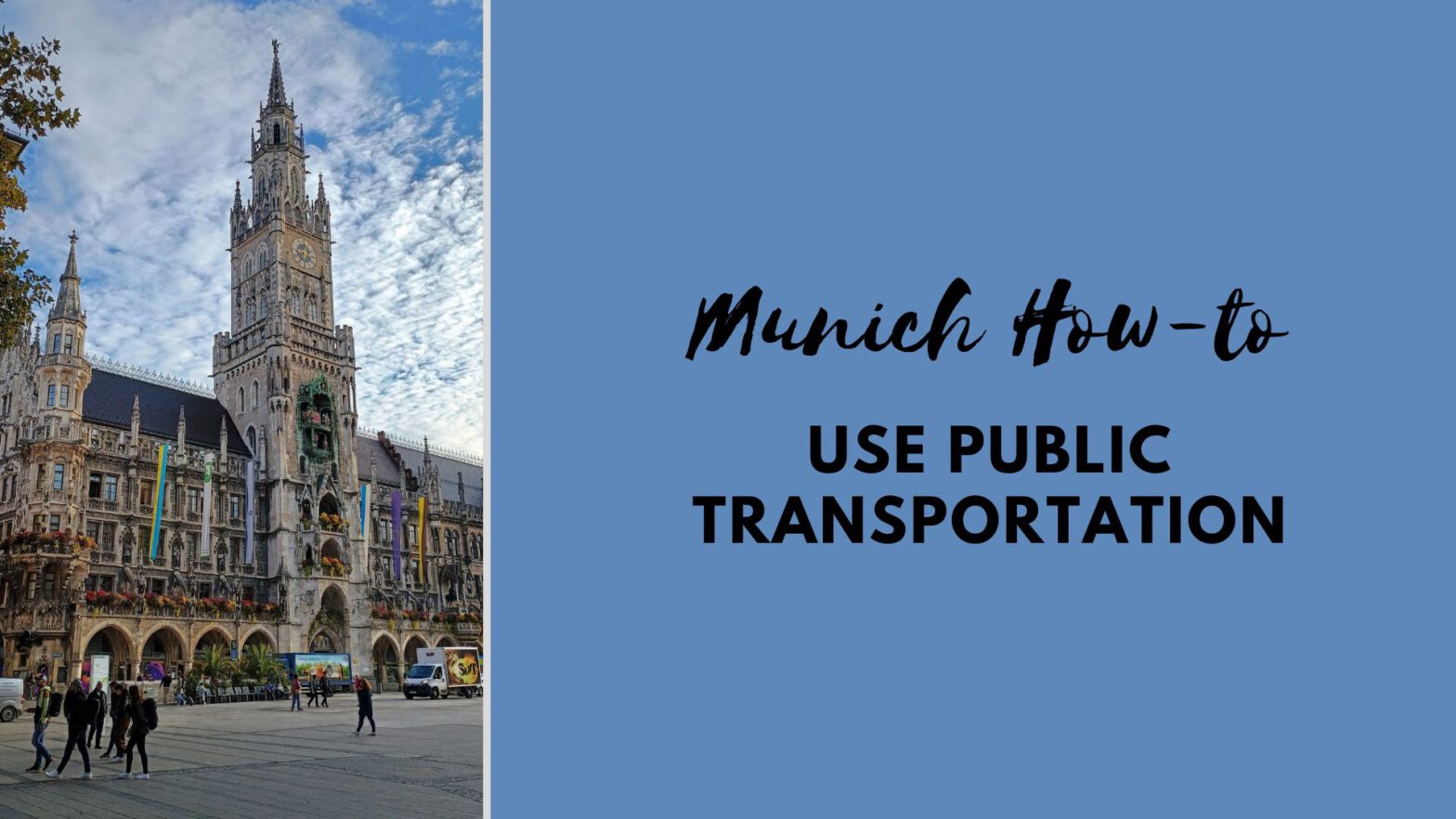You won’t need a car or an Uber in Munich – public transportation will get you almost anywhere. Munich has a dense network of subways, trams, buses and suburban trains that is safe and convenient for almost all destinations. And in this post, I’ll explain how to use it.
Take these three easy steps:
- Know where you want to go and how to get there
- Buy a ticket
- Make sure your ticket is valid for travel
Know Where You Want to Go & How to Get There
Planning Your Journey
You know where you want to go, but you don’t quite know how to get there? You have several options. Most of them will tell you the fare and let you buy tickets directly (though you will need to set up a user account).
- The MVV Homepage has a journey planner tool.
- The MVV app has a journey planner tool that also suggests ticket options. To purchase tickets in the app, you need to set up an account (cumbersome).
- The DB Navigator app also lets you buy tickets (account needed).
- Google Maps or any other mapping tool of your choice.
If your trip is less straight-forward than just a few stops on the subway, you might want to use a combination of the above tools. I do this all the time. Sometimes one suggests a much shorter route than the other.
Offline, the ticket machines in subway and S-Bahn stations will let you enter your destination and will then suggest ticket options. See my detailed guide on how to use the MVV ticket machines for details.
The Most Important Stops in Munich (For Visitors)
Many of Munich’s sights are clustered around just a few stops.
- The central stop in all of Munich is Marienplatz (U3, U6, S-Bahn trains and some bus lines). This is Munich’s central square from which you can reach the city hall, Victuals Market, the cathedral, the central shopping district, the Residenz palace, and many Christmas markets. Depending on where you are arriving from, you might already want to alight at Odeonsplatz, Karlsplatz (Stachus), Sendlinger Tor, or Isartor and walk towards Marienplatz.
- To get to the Oktoberfest (or, in the winter, the Tollwood festival), you have a choice between stops Theresienwiese (U4, U5), Goetheplatz (U3, U6) and Hackerbrücke (S-Bahn trains). All stations will be equally busy.
- For the Nymphenburg palace, catch tram 17 from Sendlinger Tor or Hauptbahnhof.
- For the Chinese Tower beer garden, go to Giselastrasse (U3, U6).
- For anything to do with BMW or the Olympic Park, Olympiazentrum is a good stop.
- Local and long-distance trains leave from the central station (Hauptbahnhof) or East station (Ostbahnhof).
All these stops are in zone M.
The destinations in my list of great day trips from Munich are located in one of the outer zones, or outside the MVV network altogether (e.g., Salzburg). The airport is in zone 5.
Munich’s Public-Transportation Network
Munich has a dense network of subways, suburban trains, trams and buses.
Eight subway lines (U1 through U8) operate within the city. They run underground.
The eight suburban train lines (S1 through S8) run through the same east-west tunnel in the city, but then branch out to their final destinations in other municipalities. S1 and S8 run to Munich airport (MUC). See my in-depth guide on how to get to and from Munich airport for details.

All U and S trains run through the city center and intersect with each other at some point. There are various interchange stations. However, Munich does not have one central hub in which all the lines meet.
Network Maps
Network maps are available in every station and at every stop … normally. Sometimes the information cases get vandalized, or the old map was removed by staff and not replaced with an updated map. You can also download the current network map from the MVV website.

The MVV network recently expanded quite significantly, but most visitors will find the map „MVV network in zones M to 5“ sufficient. This map covers Munich and areas served by S-Bahn. If you will only be in the city of Munich, choose map „MVV network in zones M“. Note that the airport is in zone 5, however!
Buy Your Ticket
Unlike in Luxembourg, public transportation isn’t free in Munich. 🙁 You have to buy and be able to show a ticket at all times during your journey.
Buying a ticket is probably the most confusing aspect of using the public-transportation system in Munich. So let’s start with some background info.
What Ticket Types Are There?
The MVV offers a range of ticket options, including:
- Single-trip ticket. Great if you only want to get from A to B. Return journey not included.
- Day ticket (for individuals and for groups of up to five people). Good for unlimited travel for one whole calendar day, and until 6 AM the next day. In zone M, if you take at least three trips, this is better value (and less hassle) than single-trip tickets. (When using the Airport City Day Ticket, you are saving money with one ride between city and airport plus one more ride in the city.)
- Weekly/monthly pass. Great for long-term stays with frequent travel.
Note: Your ticket must be valid for all the zones you are crossing on your journey.
Unlike other cities, Munich does not offer a „4-trip-ticket“, where you purchase four journeys on one ticket.
Fare Zones
Since the public-transportation network covers so much ground, it operates a fare-zone system. This means that you fare will vary depending on where and how far you travel.

Roughly speaking, the city of Munich is covered by zone M. That is the large white area at the center of the network maps. It includes all the subway (U) lines, except for the three Garching stops on the northern end of U6. These, however, will be of interest for you only if you are visiting the Technical University’s Garching campus.
The airport is in zone 5. See my detailed guides on how to get to and from the airport, how to use the Lufthansa Express Airport Bus, and how to use the S-Bahn.
How To Buy Tickets in Munich
You can buy your tickets from a ticket machine (paper ticket) or from an app (virtual ticket, QR code).
Ticket machines work with touch screens. Choose your language and follow the instructions. You can also enter your destination and let the machine suggest ticket options. See my detailed guide on how to use the MVG ticket machines.
The MVV app has a functionality called MVVSwipe. This lets you buy tickets on your phone for yourself and additional people. It apparently even has a daily cap, so you will never pay more than the price of a day ticket.
If you are using the DB Navigator app (great for national and international train travel), you can purchase your MVV ticket in this app, too. No need to open a new account on yet another app! Tickets purchase on the DB Navigator app are valid for immediate travel.
What About the Deutschland Ticket?
The Deutschland Ticket is a monthly pass valid on all local and regional transportation in Germany. Besides all the MVV lines, you can also use regional trains for no additional cost. In some cases, the ticket is even valid across borders, e.g., to Salzburg (Austria). If you will spend several weeks in Germany and are planning to use local transportation a lot, this can be a great ticket.
There are two options to buy the Deutschland Ticket with a foreign credit card. These are germanytransitpass.com and europe.tranzer.com. See the Deutschland Ticket page on the Man in Seat 61 website for more information.
Make Sure Your Ticket is Valid for Travel
With your ticket in your hand or on your phone, confidently approach your subway/bus/tram/S-Bahn. But before you board, make sure your ticket is valid for travel.
If you have a paper ticket from an MVV machine, you need to get it stamped in one of these blue boxes. They can be found before you access the subway or S-Bahn platform or on the bus/tram.

Tickets purchased on an app or from DB ticket machines (e.g., located in S-Bahn stations or at the train station) are typically valid for immediate travel. They will expire within a certain timeframe, so buy them only when you are ready to travel.
Tickets Checks
Ticket checks by plainclothes inspectors occur regularly. If you are caught without a valid ticket, the fine is €60 per person. This includes paper tickets that have not been stamped (because theoretically, you can use them again).
Unfortunately, this fine also applies if you are travelling with a valid ticket for the wrong zones. For instance, let’s imagine you haven’t read this guide. You’re at the ticket machine at Ostbahnhof and you’re a bit confused by the zones. But you know that you will only be in one zone on your journey to Hirschgarten. So you choose a ticket for zone 1. Because – 1 zone, right? You stamp it and board the next westbound S-Bahn train. All good!
All good? No. You now have a valid ticket, but it’s not good for your trip – because you should have chosen a ticket for zone M. If you get a ticket check, you will be fined.
The ticket inspectors don’t care that you’re a tourist, that you did your best, that the system is confusing.
You must have a valid ticket on you prior to accessing a platform (U/S trains) or boarding a bus/tram. You must be able to present a valid ticket throughout the entire duration of your journey. Ticket checks sometimes occur at the subway exit gates. So hang on to your paper ticket until you have left the vehicle or the station! If you are traveling with a digital ticket, make sure it has properly loaded. There is usually good connectivity even in the tunnels, but you know, Murphy’s Law …
FAQs
Is It Safe to Use Public Transportation in Munich?
Yes! Absolutely!
Public transportation is widely used in Germany, not just by people too poor to own a car. Schoolkids use it without parental supervision, women use it late at night.
If anything ever happens, it’s all over the news – that’s how rare it is.
MVG, MVV, U, S, What Does All That Mean?
Germans love acronyms!
The blue subways (U trains), trams and buses form the „Münchner Verkehrsgesellschaft“ (MVG), operated by the City of Munich. The website is mvg.de.
The red S-Bahn trains are operated by Deutsche Bahn, the national train company. The website is s-bahn-muenchen.de.
In real life, you don’t have to worry about this separation. Munich operates an integrated system called „Münchner Verkehrs- und Tarifverbund“. Tickets will work across all modes of transport. The website for the entire network is mvv-muenchen.de.
You will mostly come across the term „MVV“. It’s a lot easier than „Münchner Verkehrs- und Tarifverbund“, isn’t it?
Note that the Lufthansa Express Airport Bus is not part of the MVV. You will have to buy a separate ticket for this bus service, or present the Deutschland Ticket.
Are There Ever Any Service Disruptions?
In a dense (and ageing) network such as Munich’s, service disruptions are quite common. They are listed on the MVG Disruptions page. This includes current disruptions as well as scheduled disruptions in the future.
Most disruptions are dissolved within an hour or so. If there are more serious delays on the subway, a replacement bus service will be set up.

2 Kommentare